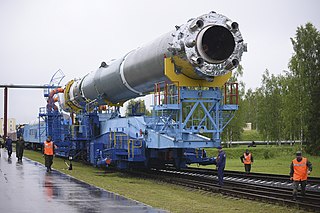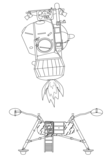
The N1/L3 was a super heavy-lift launch vehicle intended to deliver payloads beyond low Earth orbit. The N1 was the Soviet counterpart to the US Saturn V and was intended to enable crewed travel to the Moon and beyond, with studies beginning as early as 1959. Its first stage, Block A, was the most powerful rocket stage ever flown for over 50 years, generating 45.4 MN of thrust. However, each of the four attempts to launch an N1 failed in flight, with the second attempt resulting in the vehicle crashing back onto its launch pad shortly after liftoff. Adverse characteristics of the large cluster of thirty engines and its complex fuel and oxidizer feeder systems were not revealed earlier in development because static test firings had not been conducted.
The Soviet-crewed lunar programs were a series of programs pursued by the Soviet Union to land humans on the Moon, in competition with the United States Apollo program. The Soviet government publicly denied participating in such a competition, but secretly pursued two programs in the 1960s: crewed lunar flyby missions using Soyuz 7K-L1 (Zond) spacecraft launched with the Proton-K rocket, and a crewed lunar landing using Soyuz 7K-LOK and LK spacecraft launched with the N1 rocket. Following the dual American successes of the first crewed lunar orbit on 24–25 December 1968 and the first Moon landing on July 20, 1969, and a series of catastrophic N1 failures, both Soviet programs were eventually brought to an end. The Proton-based Zond program was canceled in 1970, and the N1-L3 program was de facto terminated in 1974 and officially canceled in 1976. Soviet cosmonauts never orbited nor landed on the Moon. Details of both Soviet programs were kept secret until 1990 when the government allowed them to be published under the policy of glasnost.

The NK-33 and NK-43 are rocket engines designed and built in the late 1960s and early 1970s by the Kuznetsov Design Bureau. The NK designation is derived from the initials of chief designer Nikolay Kuznetsov. The NK-33 was among the most powerful LOX/RP-1 rocket engines when it was built, with a high specific impulse and low structural mass. They were intended for the ill-fated Soviet N1F Moon rocket, which was an upgraded version of the N1. The NK-33A rocket engine is now used on the first stage of the Soyuz-2-1v launch vehicle. When the supply of the NK-33 engines are exhausted, Russia will supply the new RD-193 rocket engine. It used to be the first stage engines of the Antares 100 rocket series, although those engines are rebranded the AJ-26 and the newer Antares 200 and Antares 200+ rocket series uses the RD-181 for the first stage engines, which is a modified RD-191, but shares some properties like a single combustion chamber unlike the two combustion chambers used in the RD-180 of the Atlas V and the four combustion chambers used in the RD-170 of the Energia and Zenit rocket families, and the RD-107, RD-108, RD-117, and RD-118 rocket engines used on all of the variants of the Soyuz rocket.

Blok D is an upper stage used on Soviet and later Russian expendable launch systems, including the N1, Proton-K and Zenit.
The RD-8 is a Soviet / Ukrainian liquid propellant rocket engine burning LOX and RG-1 in an oxidizer rich staged combustion cycle. It has a four combustion chambers that provide thrust vector control by gimbaling each of the nozzles in a single axis ±33°. It was designed in Dnipropetrovsk by the Yuzhnoye Design Bureau as the vernier thruster of the Zenit second stage. As such, it has always been paired with the RD-120 engine for main propulsion.

A vernier thruster is a rocket engine used on a spacecraft or launch vehicle for fine adjustments to the attitude or velocity. Depending on the design of a craft's maneuvering and stability systems, it may simply be a smaller thruster complementing the main propulsion system, or it may complement larger attitude control thrusters, or may be a part of the reaction control system. The name is derived from vernier calipers which have a primary scale for gross measurements, and a secondary scale for fine measurements.

The RD-58 is a rocket engine, developed in the 1960s by OKB-1, now RKK Energia. The project was managed by Mikhail Melnikov, and it was based on the previous S1.5400 which was the first staged combustion engine in the world. The engine was initially created to power the Block D stage of the Soviet Union's abortive N-1 rocket. Derivatives of this stage are now used as upper stages on some Proton and Zenit rockets. An alternative version of the RD-58 chamber, featuring a shorter nozzle, was used as the N-1's roll-control engine.

The LK was a lunar module developed in the 1960s as a part of several Soviet crewed lunar programs. Its role was analogous to the American Apollo Lunar Module (LM). Three LK modules, of the T2K variant, were flown without crew in Earth orbit, but no LK ever reached the Moon. The development of the N1 launch vehicle required for the lunar flight suffered setbacks, and the first Moon landings were achieved by US astronauts on Apollo 11. As a result, having lost the Space Race, both the N1 and the LK programs were cancelled without any further development.
The LEK Lunar Expeditionary Complex was a lunar expedition and Moon base proposed by Valentin Glushko in 1974 as a Soviet response to the United States' Apollo program and as a successor to the Zvezda moonbase, which was based on the cancelled N1-L3 crewed Moon expedition program. If implemented, it was intended to have been operational by 1980 and used for scientific and engineering research.
KVD-1 was an upper stage LOX/LH2 cryogenic engine developed by the Isayev Design Bureau (now KB KhIMMASH) of Russia in the early 1960s. It is a modified version of the RD-56, developed for a never-completed cryogenic upper stage of the N-1 super-heavy lift rocket, with the goal of enabling crewed lunar missions by the USSR. The KVD-1 produces a thrust of 7.5 tonnes.
The RD-843 is a Ukrainian single nozzle liquid propellant rocket engine burning pressure-fed UDMH and nitrogen tetroxide. It is rated for up to 5 restarts, and can gimbal up to 10 degrees in each direction.

The RD-0110R is a rocket engine burning kerosene in liquid oxygen in a gas generator combustion cycle. It has four nozzles that can gimbal up to 45 degrees in a single axis and is used as the vernier thruster on the Soyuz-2-1v first stage. It also has heat exchangers that heat oxygen and helium to pressurize the LOX and RG-1 tanks of the Soyuz-2.1v first stage, respectively. The oxygen is supplied from the same LOX tank in liquid form, while the helium is supplied from separate high pressure bottles.
The RD-0214 (GRAU Index: 8D811) is a rocket vernier engine burning N2O4 and UDMH in a gas generator cycle. It has four nozzles that can each gimbal 45 in plane to provide TVC to the RD-0212 propulsion module of Proton third stage. It is a revised version of the RD-0207.

The RD-0210 (GRAU Index: 8D411K) is also known as the RD-465. It and its twin, the RD-0211, are rocket engines burning N2O4 and UDMH in an oxidizer rich staged combustion cycle. They have single nozzle, possess TVC and are the latest evolution in the RD-0203/4 lineage. They are the engines used on the Proton second stage. The RD-0213 is a fixed nozzle variation that is used on the RD-0212 module of the Proton third stage.
The RD-810 (РД-810) is a Ukrainian liquid propellant rocket engine burning LOX and Kerosene (RG-1) in a staged combustion cycle. It has a single combustion chamber that provides thrust vector control by gimbaling of the nozzle in two axis by +/- 8°. It is being designed in Ukraine by Yuzhnoye Design Bureau for the prospective first stage propulsion of the Mayak rocket family.
The RD-861 is a Soviet liquid propellant rocket engine burning UDMH and nitrogen tetroxide in a gas generator combustion cycle. It has a main combustion chamber, with four vernier nozzles fed by the gas generator output. It can be reignited a single time.
The RD-855 (GRAU Index 8D68M]), also known as the RD-68M, is a liquid-fueled rocket engine with four nozzles. As a vernier engine, it provides fine steering adjustments for rockets. It is powered by a combination of N2O4, an oxidizer, and UDMH, a propellant. This combination is hypergolic, meaning the two substances ignite on contact, eliminating the need for an external ignition source.
The RD-856 (GRAU Index 8D69M), also known as the RD-69M, is a four-nozzle liquid-fuel rocket vernier engine, burning N2O4 and UDMH in a gas generator cycle. It was used on the R-36, Tsyklon-2 and Tsyklon-3 second stage as thrust vector control by gimbaling of its nozzle. The engine is distributed through a cylindrical structure that is integrated around the main engine RD-252 module. The structure includes aerodynamic protection for the nozzles. The engine was started by a pyrotechnic ignitor.
The RD-864 is a Soviet liquid propellant rocket engine burning UDMH and nitrogen tetroxide in a gas generator combustion cycle. It has a four combustion chambers that provide thrust vector control by gimbaling each nozzle in a single axis ±55°. It is used on the third stage of the R-36M UTTKh and Dnepr. For the R-36M2, an improved version, the RD-869 was developed.
The RD-801 is a Ukrainian liquid propellant rocket engine burning LOX and Kerosene (RG-1) in a staged combustion cycle. It has a single combustion chamber that provides thrust vector control by gimbaling of the nozzle in two axis by +/- 6°. It is being designed in Ukraine by Yuzhnoye Design Bureau for the prospective first stage propulsion of the Mayak rocket family.










